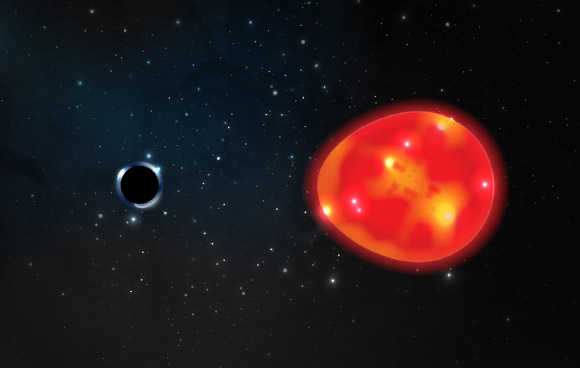The newly-discovered stellar-mass black hole candidate is a binary companion to a nearby red giant called V723 Mon.

An artist’s impression of the V723 Mon binary system. Image credit: Lauren Fanfer / Ohio State University.
V723 Mon is a bright, evolved red giant located 1,500 light-years away in the constellation of Monoceros.
Also known as HD 45762, SAO 133321, and TIC 43077836, the star has the same mass as the Sun, but is 25 times larger.
V723 Mon had been well-documented by several telescope systems, including KELT, ASAS, and NASA’s Transiting Exoplanet Survey Satellite (TESS).
But when Ohio State University astronomer Tharindu Jayasinghe and colleagues analyzed the archival data, they noticed something they couldn’t see appeared to be orbiting the red giant, causing the light from that star to change in intensity and appearance at various points around the orbit.
Something, they realized, was tugging at the red giant and changing its shape. That pulling effect, called a tidal distortion, offers astronomers a signal that something is affecting the star.
One option was a black hole, but it would have to be small — less than five times the mass of the Sun, falling into a size window that astronomers call the ‘mass gap.’
“When we looked at the data, this black hole — dubbed the Unicorn — just popped out,” Jayasinghe said.
“The simplest explanation is that it’s a black hole — and in this case, the simplest explanation is the most likely one,” added Dr. Todd Thompson, also from the Ohio State University.
The velocity of V723 Mon, the period of the orbit and the way in which the tidal force distorted the red giant told them the black hole’s mass, leading the team to conclude that the Unicorn black hole was about three solar masses.
“In recent years, more large-scale experiments to try and locate smaller black holes have launched, and I expect to see more mass gap black holes discovered in the future,” Dr. Thompson said.
“I think the field is pushing toward this, to really map out how many low-mass, how many intermediate-mass and how many high-mass black holes there are, because every time you find one it gives you a clue about which stars collapse, which explode and which are in between.”
The results will be published in the Monthly Notices of the Royal Astronomical Society.
_____
T. Jayasinghe et al. 2021. A Unicorn in Monoceros: the 3M⊙ dark companion to the bright, nearby red giant V723 Mon is a non-interacting, mass-gap black hole candidate. MNRAS, in press; arXiv: 2101.02212







